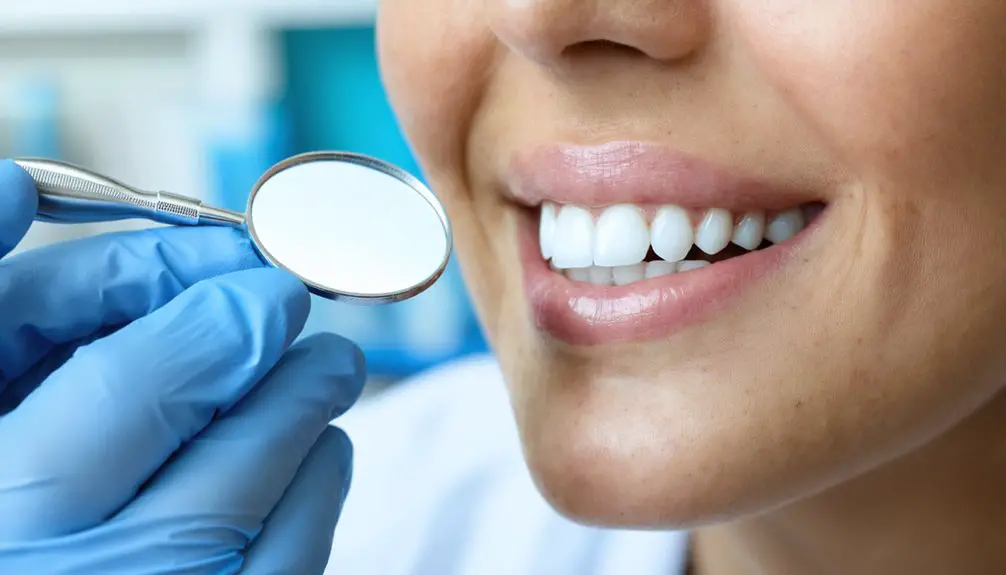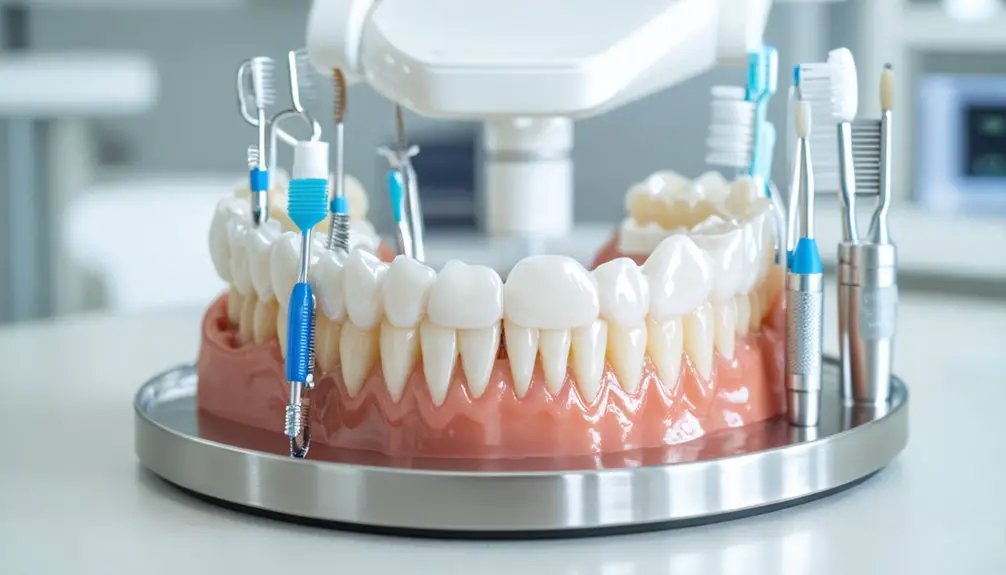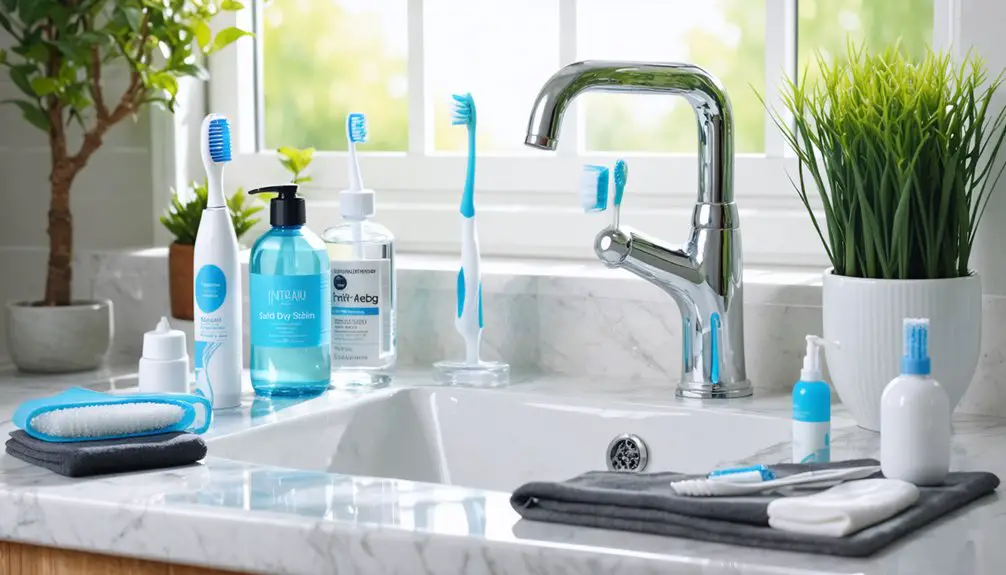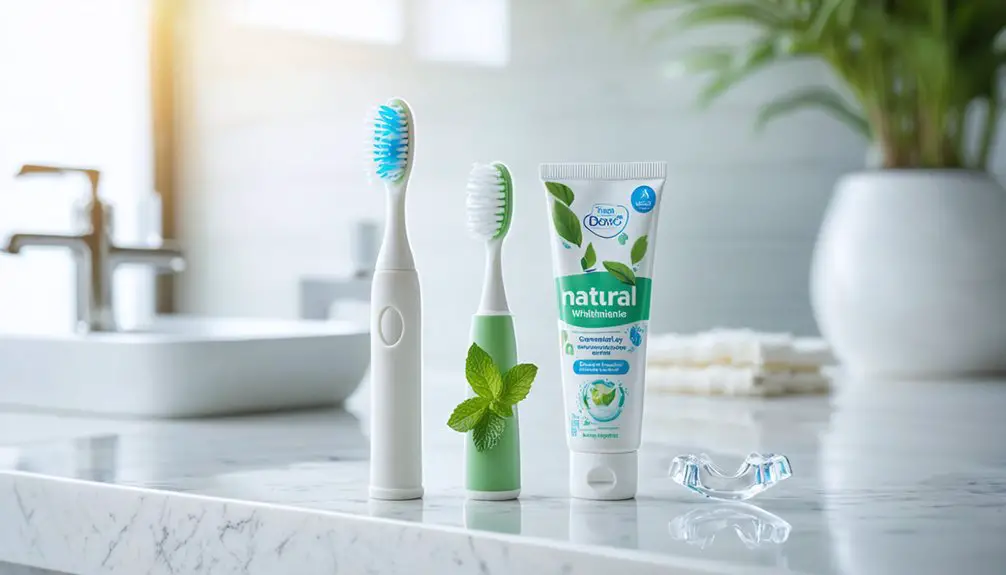To protect your enamel while whitening, always choose professional treatments from licensed dentists for maximum safety and effectiveness. Follow product instructions precisely for at-home treatments, and avoid risky DIY methods that can permanently damage teeth. Time your sessions appropriately, use fluoride products daily, and maintain regular dental checkups to monitor enamel health. Shield your teeth during acidic meals by waiting 30 minutes before brushing. These evidence-based strategies will help you achieve a brighter smile while preserving your enamel’s integrity.
Key Takeaways
- Choose professional whitening treatments over DIY methods to ensure proper peroxide concentrations and protective measures for your enamel.
- Follow manufacturer instructions precisely for at-home treatments and use only the recommended amount of whitening gel.
- Schedule regular dental checkups to monitor enamel thickness and receive professional guidance on safe whitening practices.
- Use fluoride toothpaste and mouthwash daily to strengthen enamel and promote remineralization during whitening treatments.
- Stop whitening immediately if sensitivity occurs and consult a dentist for a personalized treatment plan that preserves enamel health.
Choose Professional Whitening for Maximum Safety
While many people are tempted by over-the-counter whitening products, professional teeth whitening performed by licensed dentists offers the safest and most effective approach to brightening your smile. The in-office blue light treatment delivers superior whitening results.
Dentists guarantee proper peroxide concentrations and application techniques, protecting your gums while achieving up to 10 shades of improvement with a 90% success rate. For optimal results with minimal discomfort, dentists typically use 10% carbamide peroxide concentrations.
Professional whitening prioritizes enamel preservation through customized treatment plans that consider your unique oral health factors.
Custom treatment plans protect your enamel during professional whitening by accounting for individual oral health needs and conditions.
Your dentist will assess enamel thickness and existing restorations before proceeding. They’ll also implement protective measures like desensitizing gels and fluoride treatments to minimize sensitivity.
With professional supervision, any surface changes to your enamel are reversible, and long-term studies show no significant damage when proper protocols are followed.
Follow Instructions on At-Home Whitening Products
Although at-home teeth whitening products offer convenience and affordability, following the manufacturer’s instructions precisely is crucial for both safety and ideal results.
For proper whitening gel application, use a small drop per tooth, totaling about 1/4 to 1/5 cc for a full tray. Brush and floss teeth thoroughly before starting any whitening treatment. Confirm you’re only applying gel to natural teeth, as it won’t affect crowns or bridges. The gel contains 20% water content to help prevent tooth dehydration during the whitening process.
For proper tray usage, clean and dry them before each application. Follow the recommended wearing times based on gel concentration: 30-40 minutes for 35% gel, 2-4 hours for 20%, and 4-6 hours for 15%.
After use, clean trays with cold water and store them in a protective case. If you experience sensitivity or irritation, discontinue use and consult your dentist immediately.
Skip the Dangerous DIY Treatments
Many people turn to DIY teeth whitening treatments seeking quick, affordable results, but these methods pose serious risks to oral health.
The DIY dangers include harsh chemicals and abrasive ingredients that can cause permanent enamel erosion, leading to increased tooth sensitivity and vulnerability to decay.
Without professional oversight, you’re likely to experience uneven whitening, gum irritation, and chemical burns from improper application.
DIY treatments often damage dental work and can’t address underlying structural discoloration. Some users develop an unhealthy obsession with teeth whitening known as bleachorexia.
The risk of long-term damage increases as these unregulated methods strip essential minerals from your teeth, weakening their protective layer.
Instead of DIY solutions, using products with ADA Seal of Acceptance ensures safety and effectiveness for your teeth whitening needs.
You’ll also miss important dental evaluations that could identify contraindications or existing oral health issues.
To protect your smile, avoid DIY whitening and consult a dental professional for safe, effective treatment options.
Protect Your Teeth During Acidic Meals
Since acidic foods and beverages pose a significant threat to dental health, protecting your teeth during meals requires strategic planning and awareness.
You’ll minimize enamel erosion by consuming acidic foods during main meals rather than as standalone snacks. This meal timing approach allows your saliva to better neutralize harmful acids.
To protect your teeth while enjoying acidic foods, pair them with dairy products like cheese or milk, which help neutralize acids. Regular consumption of calcium-rich foods strengthens tooth enamel and provides additional protection against erosion.
Starchy snacks and treats should be avoided between meals since they break down into harmful sugars that feed bacteria.
Don’t forget to drink water throughout your meal to rinse away acidic residue. For additional protection, include crunchy vegetables in your meals to stimulate saliva production.
After eating, resist brushing immediately; instead, rinse your mouth with water and wait at least 30 minutes before brushing to prevent further enamel damage when your teeth are most vulnerable.
Time Your Whitening Sessions Properly
Strategic timing of teeth whitening treatments plays a critical role in achieving ideal results while protecting your dental health.
When planning for important events, schedule professional whitening 2-3 weeks in advance to allow for best color development and sensitivity recovery. For at-home treatments, begin 3-4 weeks before your target date. Starting treatment early allows for teeth to settle and any sensitivity issues to resolve before your special occasion.
Maintain proper whitening frequency by spacing professional treatments at least 6 months apart. Regular use of sensitivity-specific toothpaste can help prepare your teeth for future whitening sessions. If you’re using at-home kits, start with 30-minute sessions and adjust based on sensitivity.
For event planning purposes, remember that in-office treatments typically achieve 7-8 shades of improvement in one session, while at-home products work more gradually due to lower peroxide concentrations.
Monitor your exposure times carefully – 15-20 minutes for professional treatments and up to 2 hours for heavily stained teeth using at-home products.
Use Fluoride to Strengthen Enamel
Incorporating fluoride into your dental care routine provides essential protection for tooth enamel through dual mechanisms of action.
First, fluoride benefits include promoting remineralization by depositing minerals back into enamel and forming acid-resistant fluorapatite crystals. Second, it inhibits harmful bacteria that produce damaging acids.
You’ll find multiple remineralization techniques available to strengthen your enamel. Use fluoride toothpaste daily, rinse with a fluoride mouthwash, and consider professional fluoride treatments if you’re at higher risk for decay.
Your dentist can apply concentrated fluoride varnishes that adhere longer to your teeth for enhanced protection. For ideal results, combine these methods while following recommended guidelines to guarantee safe, effective fluoride exposure.
Regular fluoride use can reduce your cavity risk by approximately 25% while maintaining stronger, more resilient enamel.
Monitor Your Enamel Health With Regular Checkups

You’ll need consistent six-month dental checkups to properly monitor your enamel health before, during, and after whitening treatments.
Your dentist can track changes in your enamel thickness using advanced diagnostic tools like fluorescence imaging and microscopic examination to detect early signs of erosion.
A thorough pre-whitening assessment helps determine if your enamel is strong enough for bleaching procedures and allows your dentist to recommend the safest whitening approach for your specific situation.
Regular Dental Exam Schedule
Regular dental checkups serve as the cornerstone of maintaining healthy tooth enamel and preventing whitening-related complications.
You’ll need to schedule visits every six months as the standard recommendation for ideal dental hygiene, though your specific needs may vary based on your oral health status.
If you have active periodontal disease or a history of dental issues, you might require more frequent visits, potentially every 2-4 months.
Your dentist will evaluate your enamel integrity, check for sensitivity, and assess gum health during these appointments. They’ll also monitor how well you’re maintaining your oral health between visits and adjust recommendations accordingly.
For the best protection of your enamel during whitening treatments, don’t skip these essential checkups.
Your dentist can identify early signs of wear and provide timely interventions to prevent damage.
Track Enamel Thickness Changes
Modern dental imaging techniques now allow precise monitoring of your enamel thickness during whitening treatments.
Swept-source optical coherence tomography (SS-OCT) and high-frequency ultrasound provide highly accurate thickness assessments without exposing you to radiation, with measurement errors of only 0.04mm.
Regular enamel monitoring helps your dentist detect early signs of wear or erosion that whitening agents might cause.
This precise thickness assessment guides treatment decisions, ensuring whitening procedures don’t compromise your enamel integrity.
You’ll benefit from personalized care as your dentist tracks changes and adjusts treatments accordingly.
While traditional X-rays offer limited precision, these advanced imaging methods enable frequent, comfortable monitoring of your enamel health.
Ask your dental provider about available enamel monitoring technologies to protect your smile during whitening treatments.
Pre-Whitening Assessment Benefits
Before starting any whitening treatment, a thorough pre-assessment by your dentist serves as a critical safeguard for your oral health. This dental consultation enables detection of underlying issues like cavities, gum disease, or enamel erosion that could compromise your whitening results.
Your dentist will evaluate your teeth’s condition and customize the whitening preparation to minimize sensitivity risks while maximizing effectiveness.
- Professional screening identifies allergies to whitening agents and determines if you’ll need pre-treatment for conditions like plaque buildup.
- Detailed examination allows selection of the most suitable whitening method – whether in-office treatment or take-home trays.
- Baseline documentation of your oral health helps track changes during whitening and supports long-term monitoring of your enamel integrity.
Frequently Asked Questions
Can Teeth Whitening Affect Existing Dental Work Like Crowns or Veneers?
Whitening methods won’t change your dental restorations like crowns or veneers since they’re made of artificial materials. Your natural teeth will whiten, but restorations will stay their original shade.
How Long Should I Wait After Whitening Before Drinking Coffee or Wine?
Don’t jump the gun! You’ll need to wait a full 48 hours after whitening before consuming coffee or wine. This whitening duration is essential since your teeth’s heightened porosity increases beverage impact risks.
Is It Safe to Whiten Teeth While Pregnant or Breastfeeding?
You shouldn’t whiten teeth during pregnancy or breastfeeding due to uncertain safety risks. Instead, explore whitening alternatives like peroxide-free toothpaste or natural methods until after nursing to protect both you and baby.
Can Whitening Make Teeth Look Unnaturally White or Too Bright?
Picture perfect isn’t always perfect: Yes, excessive whitening can create unnaturally bright teeth. Over whitening effects include a fake, bleached appearance that detracts from your natural appearance and may damage enamel.
Should Sensitive Teeth Be Whitened Differently Than Regular Teeth?
Yes, sensitive teeth require gentler whitening techniques with lower peroxide concentrations. You’ll need specially formulated products containing desensitizing agents, shorter treatment times, and should consult your dentist for personalized recommendations.
References
- https://www.champaigndentalgroup.org/about-us/blog-articles/how-to-whiten-enamel
- https://www.eastridgedentalgreenbay.com/teeth-whitening-cause-enamel-loss/
- https://www.glendaleheightsfamilydental.com/blogs/role-of-enamel-in-teeth-whitening
- https://pmc.ncbi.nlm.nih.gov/articles/PMC4058574/
- https://www.pronamel.us/healthy-living/healthy-strong-teeth/natural-teeth-whitening-and-enamel-damage/
- https://www.loudfamilydentistry.com/blog/teeth-whitening-related-statistics-on-effectiveness-and-sensitivity-incidence
- https://www.ashbydentalgroup.com/is-teeth-whitening-safe
- https://www.thedentalspajersey.com/blog/teeth-whitening-statistics-2024
- https://pmc.ncbi.nlm.nih.gov/articles/PMC9915942/
- https://www.robertsolowdds.com/wp-content/uploads/2017/09/Teeth_Whitening_InsDirections_on_use_of_professional_bleaching_gel_and_whitening_trays.pdf



